ARSR-4
Description of the radar set, tactical-technical characteristics

Figure 1: ARSR-4
| Specifications | |
|---|---|
| frequency: | 1 215 − 1 400 MHz |
| pulse repetition time (PRT): | |
| pulse repetition frequency (PRF): | |
| pulsewidth (τ): | 150 μsec NLFM
(sub-pulses: 90 µsec; 60µsec) |
| receive time: | |
| dead time: | |
| peak power: | 65 kW |
| average power: | 3.5 kW |
| instrumented range: | 250 NM |
| range resolution: | 323 m |
| accuracy: | |
| beamwidth: | 1.5º |
| hits per scan: | |
| antenna rotation: | 5 rpm |
| MTBCF: | |
| MTTR: | |
ARSR-4
The ARSR-4 (Air Route Surveillance Radar) is a coherent, three-dimensional, solid-state, unattended, long rang surveillance radar operating in L-Band. The military nomenclature of the ARSR-4 is the AN/FPS-130.
The ARSR-4 generates dual stacks of elevation beams for optimum time energy management. The wideband antenna with multiple and selectable receive beams (dual stacks of elevation beams) aid reducing false targets. The array-fed aperture provides azimuth sidelobes below -35 dB, and circular polarisation to enhance detection of aircraft in weather.
The solid-state transmitters waveform is intrapulse modulated with non-linear frequency modulation. The pulse is divided into 2 subpulses, that are transmitted in different carrier frequencies (frequency diversity). The radars accuracy is in range 1/16 NM (116 m); in bearing 0.176 degrees, and in height 3 000 ft (914 m). Eight pulse Doppler filters suppress clutter out to 400 km (216 NM).
The modular digital target extractor and tracker is designed to process 800 aircraft plus 200 non-aircraft reports per scan, with a 50 per cent reserve capacity, and is expandable to greater capacity. The integrated secondary radar ATCBI-6M is fully compatible with the ICAO and ATCRBS mode S and military IFF mode 4. ARSR-4 provides weather processing of six levels.
The transmitter is located below the rotary joint allowing repair to occur while the system is in operation. Built-in automatic reconfiguration, reserve capacity and redundancy contribute to high availability. The system is unmanned with remote control and monitoring and remote fault detection and analysis.
Enroute air traffic in the U.S. is tracked by forty-four ARSR-4 radars along the borders and coasts.
